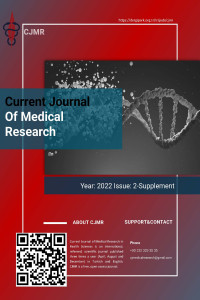Abstract
Amaç: Tıp fakültesi eğitimi süresince öğrenciler çeşitli aşamalarda kaygı yaratan çok sayıda durumla mücadele etmek zorunda kalmaktadırlar. Bu çalışmada tıp fakültesi öğrencilerinin gelecek ile ilgili kaygı durumunun demografik değişkenlerle ilişkisinin Depresyon Anksiyete Stres Ölçeği (DASS-21) ve Beck Depresyon Envanteri kullanılarak değerlendirilmesi amaçlanmıştır.
Gereç ve Yöntemler: Çalışmamız İzmir Kâtip Çelebi Üniversitesi Tıp Fakültesi’ ndeki 2021-2022 Eğitim-Öğretim yılında öğrenim gören öğrencilere 6 sorudan oluşan anket formu, DASS-21, Beck Anksiyete Ölçeği olarak Google Form üzerinden uygulanmıştır. Veriler IBM SPSS Statistics v.26 paket programında değerlendirilmiştir.
Bulgular: Çalışmaya 53’ü kadın 38’i erkek olmak üzere 91 öğrenci katılmıştır. Kadınların DASS- 21 ölçek toplam puanları erkeklerden farklı bulunmuştur (p=0,018). Kadın öğrencilerin DASS- 21 ölçeği medyan değeri (23,00), erkek öğrencilerin ölçek medyan değerinden (18,00) yüksek bulunmuştur. Kadınlar ve erkekler arasında DASS-21 anksiyete ve stres alt ölçek toplam puanları istatiksel olarak farklı bulunmuştur (p=0,022; p=0,021). Kadınların DASS-21 stres alt ölçek toplam puanı daha yüksek bulunmuştur. Öğrencilerin yaş aralığı değişimi ile DASS-21 stres alt ölçek puanları arasında anlamlı fark bulunmuştur (p=0,021). Tıp fakültesini kendi isteğiyle seçmeyen öğrencilerin Beck Depresyon Envanteri toplam puanları (p=0,001), DASS-21 ölçek toplam puanı (p=0,002), DASS-21 anksiyete (p=0,029), depresyon (p=0,001) ve stres (p=0,007) alt ölçeği puanları daha yüksek bulunmuştur. Beck Depresyon Envanteri toplam puanına göre çalışmaya katılan öğrencilerin depresyon düzeyinin hafif olduğu görülmektedir.
Sonuç: Tıp Fakültesindeki eğitimin zorluğu ve sosyal nedenlerle tıp fakültesi öğrencilerinde gelecekle ilgili kaygı duyma yaygın görülen bir sorundur. Tıp fakültesini kendi isteğiyle seçmeyen öğrencilerin daha yoğun kaygı yaşadığı görülmektedir.
Keywords
Abstract
Objective: During medical education, students have to deal with many situations that cause anxiety at various stages. In this study, it was aimed to evaluate the relationship between the future anxiety of Medical Faculty students and demographic variables using the Depression Anxiety Stress Scale (DASS-21) and Beck Depression Inventory.
Material and Methods: Our study was applied to the students studying at Izmir Katip Celebi University Faculty of Medicine in the 2021-2022 academic year, using a questionnaire consisting of 6 questions, DASS-21, Beck Depression Inventory, via Google Form. The data was evaluated in the IBM SPSS Statistics v.26 package program.
Results: 91 students, 53 females and 38 males, participated in the study. The DASS-21 scale total scores of women were found to be different from men (p=0.018). The median value of the DASS-21 scale for female students (23.00) was found to be higher than the scale median value for male students (18.00). DASS-21 anxiety and stress subscale total scores were statistically different between men and women (p=0.022; p=0.021). Women's DASS-21 stress subscale total score was found to be higher. A significant difference was found between the age range change of the students and the DASS-21 stress subscale scores (p=0.021). Beck Depression Inventory total scores (p=0.001), DASS-21 scale total score (p=0.002), DASS-21 anxiety (p=0.029), depression (p=0.001) and stress (p=0.001) of students who did not choose medical school voluntarily 0.007) subscale scores were found to be higher. According to the Beck Depression Inventory total score, the depression level of the students participating in the study was mild.
Conclusion: Future anxiety is a common problem among medical school students due to the difficulty of education in the Faculty of Medicine and social reasons. It is seen that students who do not choose the medical faculty voluntarily experience more intense anxiety.
Keywords
Details
| Primary Language | Turkish |
|---|---|
| Subjects | Clinical Sciences |
| Journal Section | Conference Paper |
| Authors | |
| Publication Date | December 6, 2022 |
| Submission Date | June 8, 2022 |
| Published in Issue | Year 2022 Volume: 2 Issue: 2-Supplement |


